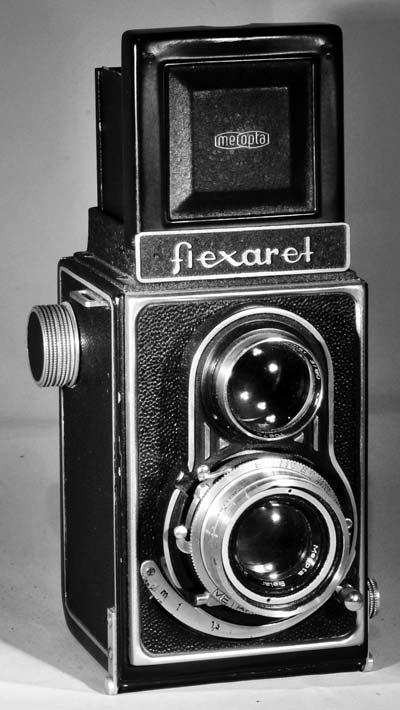Meopta Flexaret IIa
Specification

(Frankencamera)
| Manufacturer | : | Meopta |
|---|---|---|
| Produced | : | 1963 |
| Classification | : | Medium Format |
| Body Type | : | Twin Lens Reflex |
| Construction | : | Metal |
| Film Type | : | 120 |
| Film Width | : | 62mm |
| Image Size | : | 6 x 6 cm |
| No. of Images | : | 12 |
| Lens Type | : | Belar 3.5/80 |
| Focal Length | : | 80mm |
| Focus Type | : | Variable |
| Focal Range | : | 1m - inf. |
| Aperture Type | : | Iris |
| Apertures | : | f/3.5 - f/22 |
| Shutter Type | : | Metax |
| Shutter Speeds | : | B, I(1/400s to 1 sec) |
| Size Viewfinder Open (w x h x d) | : | 95 x 195 x 110 mm |
| Size Viewfinder Closed (w x h x d) | : | 95 x 138 x 110 mm |
| Weight | : | 728g |
Art Deco Credentials
![]()
![]()
Acceptable: Modest and restricted
I consider this camera to warrant 2 stars for the following attributes:
- produced after the main Art Deco period but has it's design roots in the art deco period
- Oval plate around the two lenses with some geometric markings
- Chrome embellishment around face plate
- Art Deco type font
Description
The first thing to say about my example of this camera is that it is a Frankencamera - i.e. it is made from two cameras. It has a different lens fitted. The specification is the same but the lens is from a later Flexaret Standard.
The Flexaret IIa camera was manufactured by Meopta (formerly Optikotechna) around 1963. It is part of a range of Flexaret cameras starting in 1935 (Flexaret I) and ending in 1971 (Flexaret VIIa). The Flexaret IIa is similar to the Flexaret II but with a different shutter, either a Metax or Prontor-SVS. It was fitted with either a Mirar or Belar taking lens and an Anastigmat viewing lens.
The Flexoaret takes 12 6×6cm pictures on 120 film. Film transport uses a knob and film advance is checked through a red window which is protected by a sliding cover. The large viewfinder lens produces a bright image on the ground glass screen. There is a magnifying glass that can be flipped into place to check focussing. The front of the viewfinder also drops down to produce a simple 'sports finder'.
For this particular model, the Metax shutter provided speeds from 1 to 1/400s plus bulb. The shutter is armed with one lever and fired with another around the taking lens. It has a cable release socket. A shutter delay timer is provided.
The iris of the aperture is controlled by a pointed lever around the taking lens. The aperture values are f/3.5, f/4, f/5.6, f/8, f/11, f/16 and f/22.
It has a helical focusing system operated by lever below lens. Both taking and viewing lenses move together to ensure that the viewing screen and the image on the film are in focus at the same time. The focussing can be checked in the viewfinder with the image projected onto a ground glass screen. There is a loupe for getting a close-up of the screen.
A latch, that can be unscrewed and pressed, is found on the side of the camera to unlock the film door.
A tripod socket is provided on the base and a PC flash socket is found on the lens plate.
How to Use
If you don't want to bother with an exposure meter, follow the guide shown. It is based on the 'Sunny 16' rule. Film is so forgiving and will produce acceptable results even when overexposed by 2 or 3 stops or underexposed by 1 stop.
Remember that the exposure guide that is found on the camera may not be helpful as it is based on the use of old film with a low ISO value.
The tables assume that the sun is at least 30 degrees above the horizon - that's 10am - 5pm on a summer's day in the UK.
If you are not sure about the light level, err on the side of overexposure - i.e. assume the smaller f number.
Where there is a choice, a larger f number will give a larger depth of field.
For the slower speeds, you may need a tripod to stop blur through shake.
Using ISO 100/125 film
| Weather Conditions | Shadow Detail | Shutter Speed (s) | ||
|---|---|---|---|---|
| 1/25 | 1/50 | 1/100 | ||
 Sunny SunnySnow/Sand | Dark with sharp edges | - | - | f/22 |
 Sunny Sunny | Distinct | - | f/22 | f/16 |
 Slight Overcast Slight Overcast | Soft around edges | f/22 | f/16 | f/11 |
 Overcast Overcast | Barely visible | f/16 | f/11 | f/8 |
 Heavy Overcast Heavy Overcast | None | f/11 | f/8 | f/5.6 |
 Open Shade Open Shade/Sunset | None | f/8 | f/5.6 | f/4 |